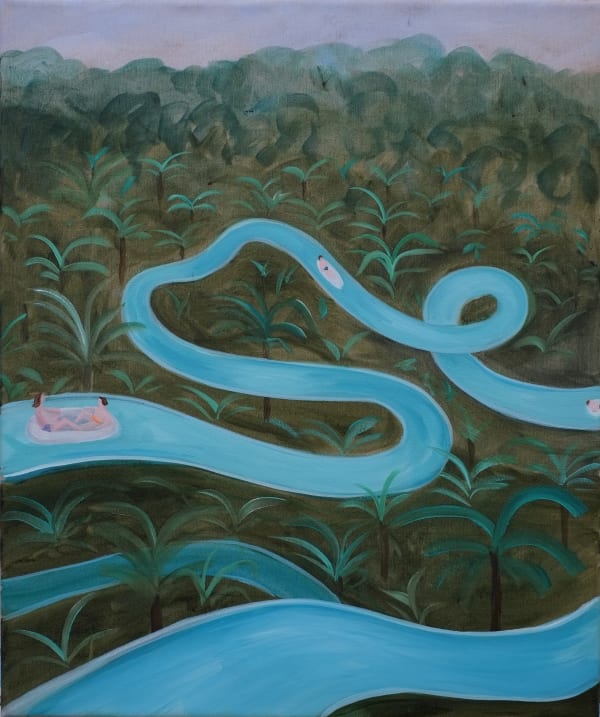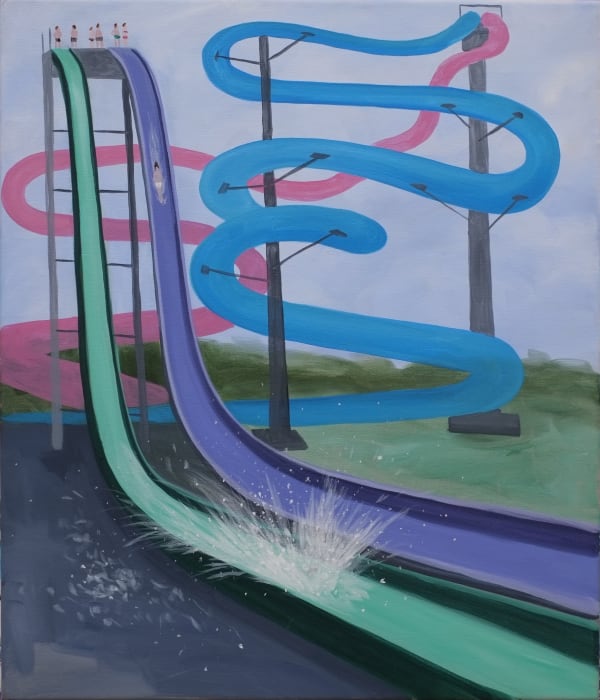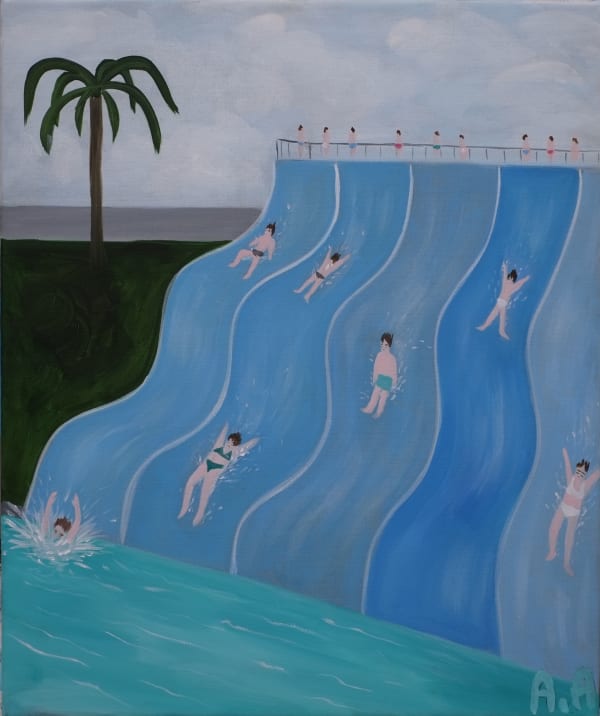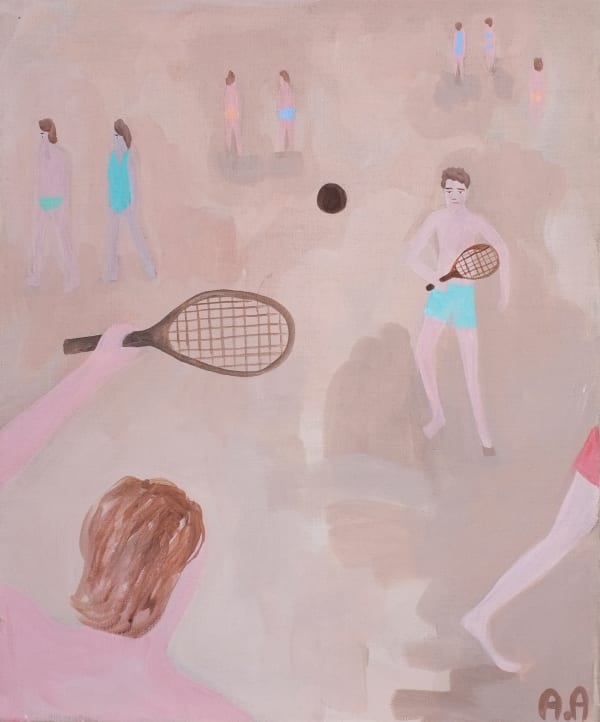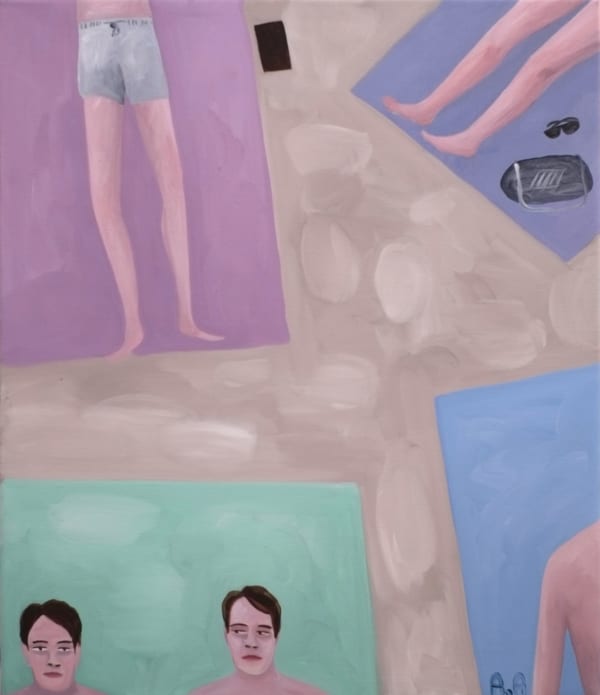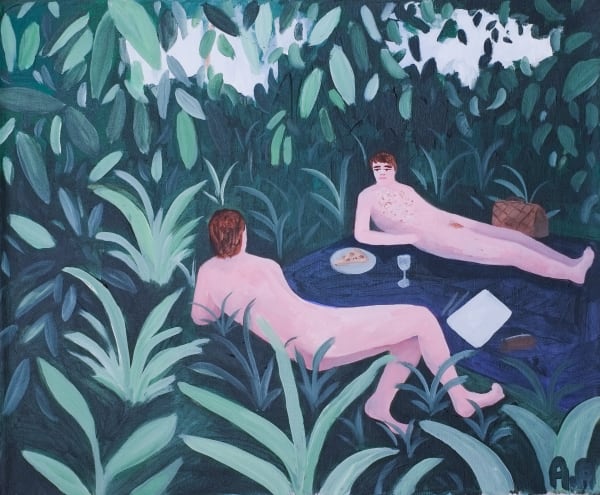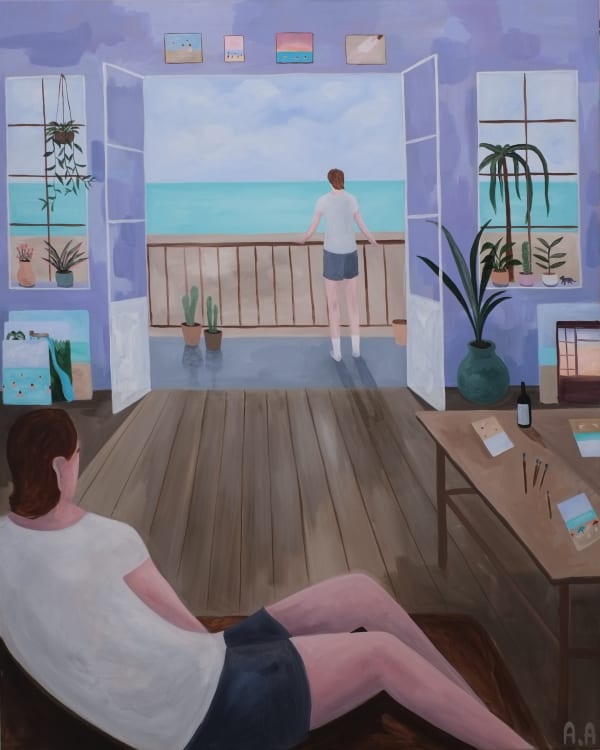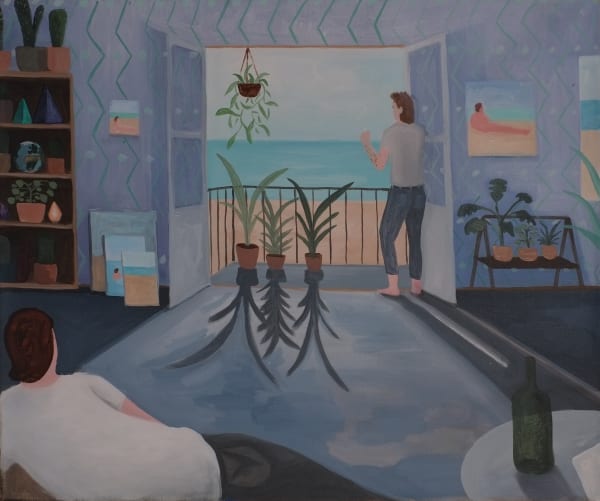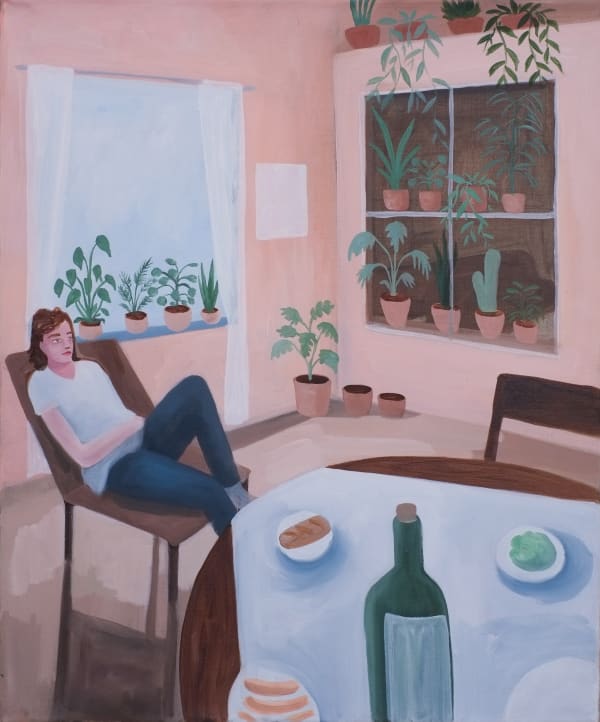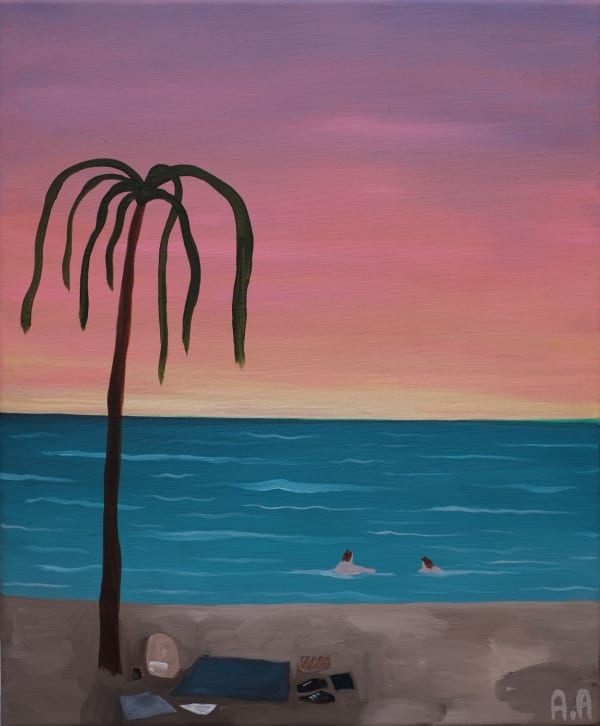-
Tan Lines
Audun Alvestad -

-
-
Solo exhibitions include Here comes a regular, QB Gallery, Oslo, Norway (2021); Inadequate, Just Inadequate, Kristin Hjellegjerde Gallery, Berlin (2020); Høyte Hårveste, QB Gallery, Oslo, Norway (2019); It’s my Party and I'll Cry If I Want to, Kristin Hjellegjerde Gallery, London (2019); Alnes fyr, Norway, July (2018); Gallery BOA, Oslo, Norway (2018); Varme Hender, Kalde Fotter, Trondelag Senter for Samtidskunt, Trondheim, Norway (2017) and Klamme Hender, Varme Fotter, Gallery Christinegaard, Bergen, Norway (2017).
-
Group exhibitions include The Easter Group Show, Galleri Thomassen, Gøteborg, Sweden (2019) and SPF 32, William Ulmer Brewery, Brooklyn (2019); as well as Specially Normal, with Christina Banban, Kristin Hjellegjerde Gallery, London (2018); Group show at QB gallery, Oslo (2018); We are the ones..., Carlsberg gallery, Copenhagen, Denmark (2017), The Summer Island Show, Gallery Kant, Denmark (2017) and Hostutstillingen, Kunstnernes Hus, Oslo, Norway (2017). He was recently awarded a three year working grant for young artists by the Arts Council of Norway (2017) and Statens utstillingsstipend, Arts Council Norway (2016), Prosjektstøtte, Arts Council Norway (2016).
Highlights and Collections
In 2017 Alvestad received a 3-year working grant for young artist from the Arts Council Norway, Prosjektstøtte, Norwegian association of Artists. In addition, in 2016 Audun Alvestad was granted Statens utstillingsstipend, from the Arts Council Norway, Prosjektstøtte.
-
-

-
-
After a period of isolation, the Lisbon-based, Norwegian artist recalls hearing suitcases being wheeled across cobblestones and was struck by the distinctiveness of the sound and its ability to conjure up a vivid reel of images and memories. He began to think about what a holiday means as a concept, how we delineate a period of time, establish expectations, wear different clothes and perform certain activities or even identities. As such, all of the paintings possess a kind of universality - we recognise the settings and the patterns of behaviour, but they do not describe individual places or people. This has the effect of allowing us, as the viewer, to perceive and understand the works through the filter of our own experience, but at the same time, we’re held at a distance as a witness rather than a participant.
Although Alvestad’s work is often characterised by a cinematic or even slightly voyeuristic perspective in which we are given glimpses into intimate, domestic scenes, these latest paintings are both more expansive and gentler than previous works. This is partly due to the soft, pastel colours that evoke the appearance of sun-bleached surfaces, but also a result of the focus on exterior spaces. The beach paintings, for example, are populated with numerous bodies and towels and yet, the sand seems to stretch endlessly, conveying a sense of both physical and mental space that relates to wider notions around holidays as a time (and place) of ease, languor and sensuality.
-
In a similar way, Alvestad borrows the setting of a water-park to evoke an experience of fun and play, but while we recognise the scene, it is romanticised to the point of being dream-like and surreal. Water-parks can be noisy and busy, and nowadays, often appear in a gradual state of deterioration, but in Alvestad’s paintings people float quietly and peacefully along vibrantly coloured slides that curve through lush forests, or extend from great heights, seemingly continuing beyond the edges of the canvas. Silence pervades even in the works where splashes of water erupt from the surface or bodies slip speedily down steep flumes.
Some scenes appear to occur late in the day, when the sky is turning various shades of pink and orange and shadows are long, while others are flattened by the glare of the sun. In one painting, a figure is frozen, at the moment just before they drop from the end of a slide, while elsewhere a man reaches his hand up to catch a frisbee in the sea. Time is paused, and with it comes a creeping sense of foreboding that anticipates the end of a moment and the inevitable experience of loss. In this way, we find ourselves caught not only in the image of the painting, but in our own vivid and unsettling flashes of memory.
-
-
-
 Audun Alvestad, I just want to be free, 2021
Audun Alvestad, I just want to be free, 2021 -
 Audun Alvestad, Good at being cute , 2021
Audun Alvestad, Good at being cute , 2021 -
 Audun Alvestad, This time its gonna be different, 2021
Audun Alvestad, This time its gonna be different, 2021 -
 Audun Alvestad, Better now, 2021
Audun Alvestad, Better now, 2021
-
 Audun Alvestad, Can't blame it all on the frequencies, 2021
Audun Alvestad, Can't blame it all on the frequencies, 2021 -
 Audun Alvestad, Over and over , 2021
Audun Alvestad, Over and over , 2021 -
 Audun Alvestad, Everything is in motion, yet nothing really changes, 2021
Audun Alvestad, Everything is in motion, yet nothing really changes, 2021 -
 Audun Alvestad, Lets get into the water, 2021
Audun Alvestad, Lets get into the water, 2021
-
 Audun Alvestad, All downhill from here, 2021
Audun Alvestad, All downhill from here, 2021 -
 Audun Alvestad, Today, we are young, 2021
Audun Alvestad, Today, we are young, 2021 -
 Audun Alvestad, I doubt I'll find one like that again, 2021
Audun Alvestad, I doubt I'll find one like that again, 2021 -
 Audun Alvestad, Bad news, 2021
Audun Alvestad, Bad news, 2021
-
 Audun Alvestad, This time its gonna be different (mini version), 2021
Audun Alvestad, This time its gonna be different (mini version), 2021 -
 Audun Alvestad, It happened in August, 2021
Audun Alvestad, It happened in August, 2021 -
 Audun Alvestad, Don't be afraid of love and affection, 2021
Audun Alvestad, Don't be afraid of love and affection, 2021 -
 Audun Alvestad, Plasticity is just change, 2021
Audun Alvestad, Plasticity is just change, 2021
-
 Audun Alvestad, I'm the kind of guy that wants to listen to what you have to say, 2021
Audun Alvestad, I'm the kind of guy that wants to listen to what you have to say, 2021 -
 Audun Alvestad, Some people just want to be left alone, 2021
Audun Alvestad, Some people just want to be left alone, 2021 -
 Audun Alvestad, Never getting it right, 2021
Audun Alvestad, Never getting it right, 2021 -
 Audun Alvestad, I'm so glad you like tattoos, 2021
Audun Alvestad, I'm so glad you like tattoos, 2021
-
 Audun Alvestad, Can't let you go when you're already gone, 2021
Audun Alvestad, Can't let you go when you're already gone, 2021 -
 Audun Alvestad, Legs, 2021
Audun Alvestad, Legs, 2021 -
 Audun Alvestad, When you can do almost anything and it won't be sad, 2021
Audun Alvestad, When you can do almost anything and it won't be sad, 2021 -
 Audun Alvestad, The water looks strange today, 2021
Audun Alvestad, The water looks strange today, 2021
-
 Audun Alvestad, The ocean still looks strange, 2021
Audun Alvestad, The ocean still looks strange, 2021 -
 Audun Alvestad, You are already all there ever was, 2021
Audun Alvestad, You are already all there ever was, 2021 -
 Audun Alvestad, You're so 3D, 2021
Audun Alvestad, You're so 3D, 2021 -
 Audun Alvestad, Something happened and everything will be different, 2021
Audun Alvestad, Something happened and everything will be different, 2021
-
-
-
-
Mafafo’s practice is centred around black female empowerment both in terms of the compositions she creates and her working processes. While each scene is inspired by her personal experiences, memories and emotion states, the pieces are created collaboratively, reflecting Mafafo’s belief in art as a tool for connection and communication. Originally trained as a painter, she learnt the art of embroidery from a talented Cape Town-based, Ghanian tailor, before going on to train two women whom she works with on an ongoing basis. “One woman is from Zimbabwe and the other is Xhosa [a South African ethnic group], which creates an interesting dynamic within the work,” she says. “I give them the freedom to express themselves and develop their own style.” Crucially, the work also provides these women with financial support and a creative form of self-expression, allowing them to transcend traditional gender stereotypes that continue to be upheld in many African communities. As such, each stitch becomes a mark of defiance as well as an assertion of strength, unity and female liberation.
This is most clearly visualised in Sibambaneni (Let us lend a helping hand), a series of works that depicts various hand gestures hidden within the folds of fabric or intricate woven patterns of colourful threads. These pieces were mainly created during lockdown in South Africa when life became increasingly difficult for both individuals and communities, and the artist found herself reaching out to others, especially women, in search of support and solidarity. The physicality of the fabric itself, which appears scrunched in places as if clinging to a body, and the expressiveness of the hand gestures convey a sense of longing while also highlighting the power of human connection. However, instead of portraying suffering, Mafafo employs vibrant colours and dynamic gestures to create an impression of beauty, vitality and hope, while the irregular shape of the fabric and the loose, hanging threads express her own creative freedom. “Most of the threads are offcuts from the machine embroidery, which are recycled back into the artworks,” explains Mafafo, “but I also see them as a defiance against the neatness of traditional embroidery and image-making.”
-
A second series, after which the exhibition is titled, focuses around the figure of a woman who appears semi-nude, wrapped in a white or gold cloth, in the midst of tropical flowers and thick foliage. For Mafafo, this dreamlike landscape relates back to her childhood memories of spending time in botanical parks and gardens, and admiring the rich colours and grandeur of Dutch paintings in the William Humphrey museum in Kimberley. However, by detaching both the floral forms and the figure of the woman from a specific context, Mafafo once again asserts a sense of release and joyous abandon. Within this colourful, fluid space, the woman is able to escape her everyday realities, but also find a deeper connection to herself. The cloth in which she is wrapped symbolises this notion of harmony and protection, while also adding a further layer of sensuality and tactility to the work.
While each artwork possesses its own individual beauty and sense of aliveness, viewed together the works take on a kind of talismanic force that honours female experience and offers space for creative refuge.
-
Tan Lines: Audun Alvestad
Past viewing_room





